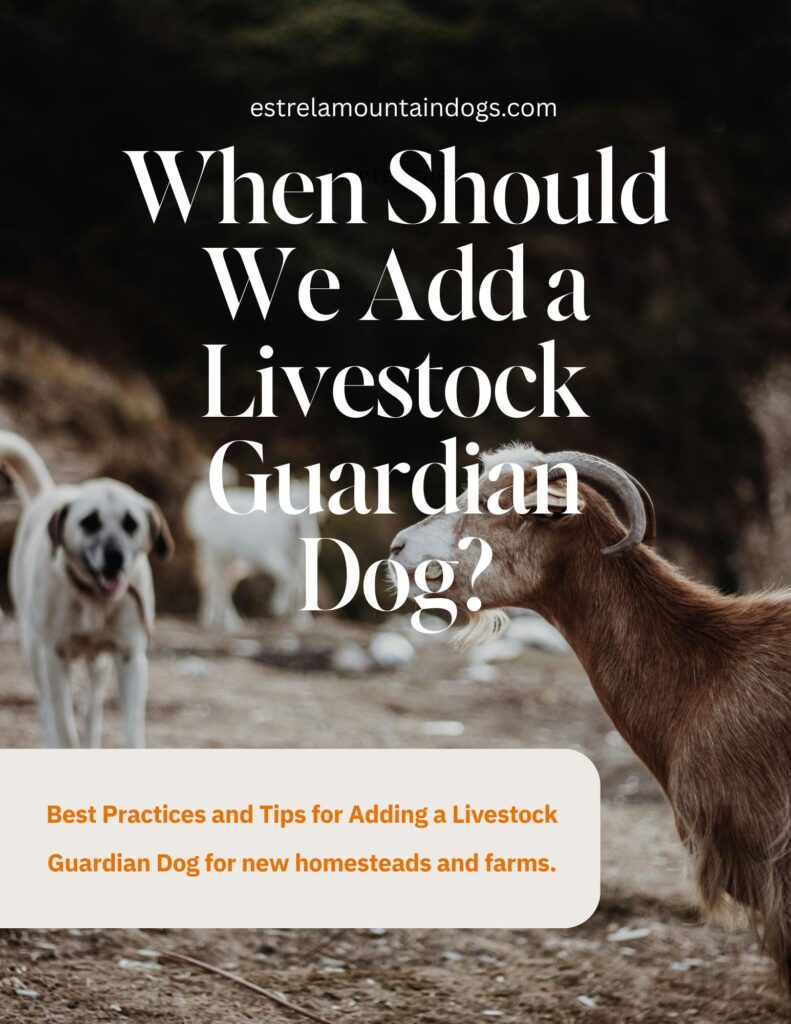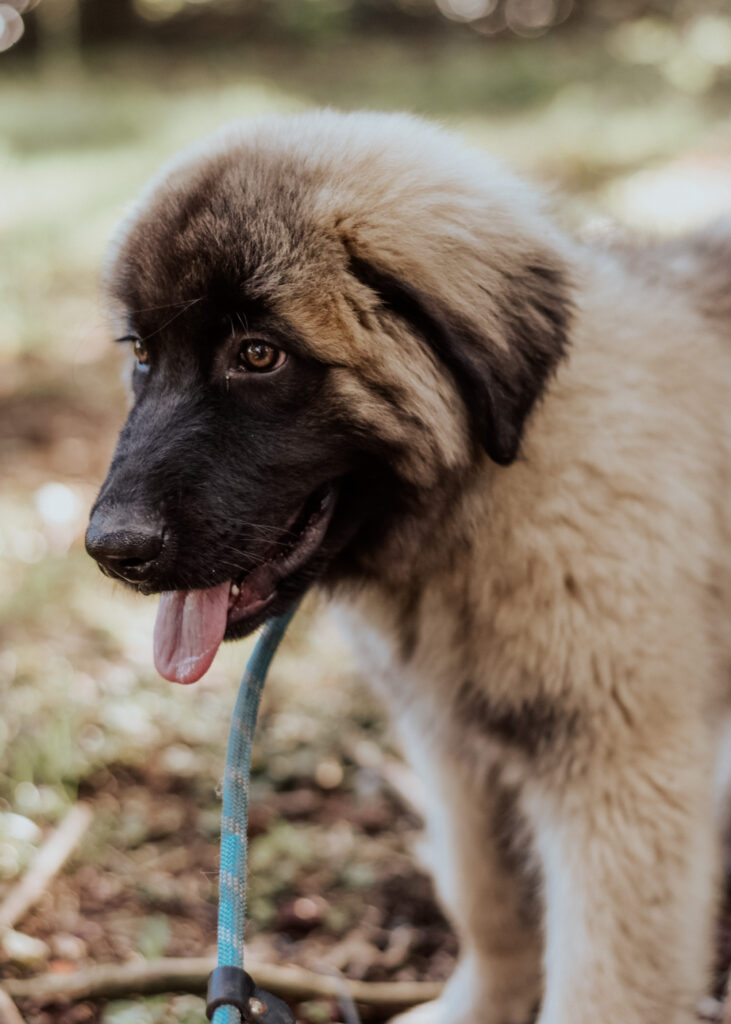
LGD Q&A for you: When should we add a livestock guardian dog to our homestead?
I get asked this question a lot: When is the right time to bring a livestock guardian dog onto a new homestead? It’s such an exciting stage when you’re buying land, planning fencing, and dreaming of chickens, goats, pigs, and maybe even alpaca or cattle down the road. But timing matters with LGDs, because they’re not just pets — they’re working partners that need the right setup to succeed.
🐕 Quick Guide: When to Add a Livestock Guardian Dog
✅ Wait for fencing + first livestock
✅ Start with goats or sheep (easier than chickens)
✅ Begin with one puppy, add a second a year later
✅ Choose the opposite sex for best compatibility
✅ Fix the first dog before the second is sexually mature
✅ Expect 12–24 months before full maturity
✅ If predators are heavy, let the pup grow up first
✅ Buy livestock already raised with LGDs
✅ Pairs work best for long-term protection
Start with fencing and infrastructure first
Before I’d ever bring in a guardian dog, I want my fencing in place. Most Livestock Guardian dogs will instinctively protect as much land as they can reach, and if there isn’t a solid perimeter, they’ll test boundaries or wander onto neighboring land. A secure fence also gives them a defined “territory” to protect, which is how their instincts lock in. Think of fencing, housing, and predator-proof setups for your first livestock as step one.
What if you already have local predators before you add stock?
If your land already has heavy predator pressure think coyotes, bears, or feral dogs, then it makes sense to bring in your livestock guardian dog before you bring in animals. The reason is simple: a puppy takes a year or more to mature into a reliable guardian. If you wait until you’ve already got goats or poultry on the ground, you may be asking a half-grown pup to fight off predators it isn’t ready for. Livestock Guardian Dogs are not able to defend appropriately until they are at least a year old and often closer to 2 years.
By giving the LGD time to grow up on your land, bond with the territory, and learn the fences, you’re setting it up to be strong and confident by the time the first livestock arrive. You’ll still need to provide structure, training, and supervision, but the dog won’t be starting from scratch while predators are already testing your setup. In areas with real predator pressure, it can be smarter to think ahead and let the dog mature into its role so it’s ready when your stock arrives.
Wait until there’s livestock on the ground
An LGD bonds best when it has stock to live with. That’s their purpose — to see the animals as “yours and then inherently because whatever belongs to you belongs to them = theirs.” If you add a guardian dog before you’ve added any animals, the dog either ends up as a yard dog or bonds more to you than to the flock or herd. That makes the transition harder later. The sweet spot is bringing in your LGD once you’ve got your first animals established, even if it’s just goats or pigs at the start.
Chickens are harder— goats and sheep are easier
Many homesteads start with chickens, but poultry are the hardest for a young LGD to learn with. They flap, run, and squeak, which triggers play or chase. Some dogs can do it, but it usually requires constant supervision. If you can, it’s often easier to introduce a puppy once you’ve added goats or sheep — sturdier animals that help the pup learn boundaries faster. The dog can still eventually bond with chickens, but goats or pigs give it a foundation of success.
Best Advice: Source livestock that already know Livestock Guardian Dogs
One of the best shortcuts when starting out is to buy livestock that were raised with guardian dogs. I am dead serious about this. Specifically look for livestock from farms that are using LGDs. Animals that grew up around LGDs already understand the dog is part of the farm and not a predator. That means less chasing, less stress, and a smoother bond for your puppy. Training goes so much faster when the livestock are calm and used to dogs instead of panicking every time one comes near. If you can source goats, sheep, or even poultry from farms that run LGDs, you’ll be saving yourself months of work and setting your pup up for easier success.
Puppy vs. adult livestock guardian dog

Whether you bring in a puppy or a trained adult changes the timeline. A puppy takes 1 to 2 years of growth, exposure, and training before it’s reliable on its own. An adult dog, if well raised, can step into the job faster, but adults can come with challenges too, like adjusting to a new farm or bonding to unfamiliar stock. For many people building a homestead slowly, a puppy raised alongside the animals from the beginning is worth the investment.
How many Livestock Guardian Dog puppies should we get?
This is one of those “it depends” questions. A single livestock guardian dog can absolutely work, especially on a smaller homestead or in areas with light predator pressure. And most new owners find it challenging to train one puppy, let alone two. But LGDs do best in pairs or more and were not meant to work alone. Two dogs can back each other up, share the workload at night, and keep each other from getting bored and wandering.
My recommendation is to start with one puppy and focus on raising and training it well. Then add a second puppy about a year later, ideally of the opposite sex, so the older dog helps guide the younger one and you avoid same-sex conflicts as they mature.
Checklist for adding multiple LGDs:
- ✅ Start with one puppy and put in the time for daily training and supervision
- ✅ Focus on bonding that first pup to the livestock and property
- ✅ Add the second puppy about one year later, ideally of the opposite sex
- ✅ Use the older dog as a mentor so the new pup learns good habits
- ✅ Keep both dogs contained with strong fencing so they stay focused on the job
- ✅ Plan to spay or neuter the first dog with OSS or GSS before the second pup reaches sexual maturity.
Think about predator pressure and long-term needs
If you’re in an area with heavy predator load — coyotes, bear, or packs of feral dogs — then getting an LGD sooner rather than later might make sense once fencing and first stock are in. For light predator areas, you can take a little more time to establish your setup before adding dogs. Also keep in mind that LGDs often work best in pairs. Many farms add a second dog once the first one matures, so there’s backup if predators test the boundaries.
Rare breeds and timing: If you are interested in a less common breed such as the Estrela Mountain Dog, you will need to plan ahead. Rare breeds only have a handful of litters each year, and most responsible breeders place puppies through a waiting list. That means you cannot always choose the exact timing. Instead, you need to be prepared to welcome the puppy when it is ready.
The good part is that this gives you time to finish fencing, prepare housing, and get your livestock settled while you wait. If you already know the Estrela is the right guardian for your homestead, the best step is to get on a waiting list early. You can apply for a puppy here if you are interested in one of our future Estrela Mountain Dog puppies.
My short answer
The best time to add a livestock guardian dog is after your fencing is up and your first livestock are in place. But if you already have heavy predator pressure, you will need to add the dog first and wait til it is mature or have a way to keep the livestock safe while the puppy matures.
Start with stock that has been raised with Livestock Guardian Dogs — goats or sheep are ideal. Expect a learning curve of 12–24 months before a pup is a finished guardian. And remember, this isn’t just about the dog learning, you’ll be learning too, as you figure out how to guide, correct, and set your new livestock guardian dog puppy up for success.
👉 Have another LGD question you’d like me to answer next week? Drop it in the comments.
And if you’re planning ahead for your first working guardian, check out our Estrela Mountain Dog puppies raised specifically for farms and homesteads that need capable protection.
Comments +